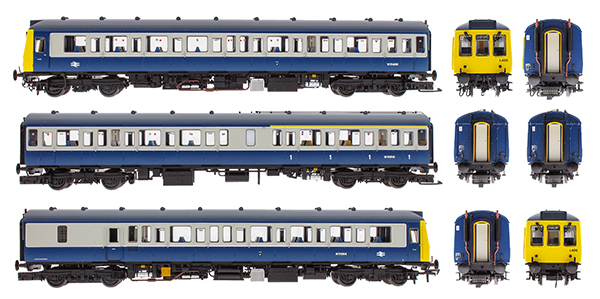07 August 2020
|
Benefitting from a new chassis design, as applied to its Class 121 and 158 models, Andy York casts a rule across the multiple unit from Barwell.
Back in September 2015, on a very pleasurable day at the Gloucestershire & Warwickshire Railway thanks to Bachmann’s Collectors Club, we saw the announcement of the Class 117 DMU project, along with the Class 121. The project took longer than anticipated, but it’s all the better for it as the new low-floor chassis design has been utilised, as with its Class 158 and 121 already reviewed.
The 42 units manufactured by Pressed Steel in 1959/60 were initially allocated to Southall and Reading for Thames Valley services to Paddington. Although synonymous with that area, the units did spread further afield, even in early years, with workings from Reading to Southampton and Portsmouth. In the early 1970s, some units were based at Bristol and in the late 1970s, around Cardiff.
The early 1990s saw Old Oak Common-based units working Gospel Oak to Barking services. From 1994, seven became two-car units with the centre TC removed to work as power twins on the Liskeard to Looe services, which would have helped with the steep climb back up to Liskeard from Coombe Junction. Around the same time, some units were based at Tyseley for Birmingham Cross-City workings, later moving to Scotland after the Cross-City electrification. Allocated to Haymarket, the Class 117s worked the Fife Circle. The latter days of the units in service also saw them work Bletchley to Bedford services under Silverlink, ending 40 years of service life in 1999.

Model variations
Comprising of three vehicles, a Driving Motor Brake Second (DMBS), Trailer Composite (TC) and Driving Motor Second (DMS), Bachmann’s Class 117 is initially available in three liveries; green, blue/grey and revised Network SouthEast. The earliest livery, BR multiple-unit green features four-character headcode panels on the roof, cab fronts without marker lights, no gangway corridor connections between vehicles and therefore the original exhaust arrangements to the inner end of the driving vehicles. The original-style cab handrails also act as downpipes from the cantrail gutters. Other features unique to the original livery are the cutaway buffers and original bogies.
The reviewed refurbished blue/grey livery depicting Southall-allocated set L426 W51364 (DMBS), W59516 (TC) and W51406 (DMS) dates the unit as post-1977 and sees changes for the era with the headcode panel plated over and marker lights on the cab front and round Oleo buffers. The full-height cab door handrail is now replaced with a shorter handrail and the bogies are of the modified style with additional dampers to improve ride quality. The addition of gangway connections between the vehicles in this era also necessitate the change to a later pattern of exhaust arrangement. A further change at this time that requires further tooling variations is the heater vent adjacent to the guard’s door on the DMBS.
Moving on to the later version in revised Network SouthEast livery (which marks it as post-1998), there's further revision, with a cab front that has the central high-intensity lamp, so Bachmann has tooled three different cabs for these initial releases.

Attention to detail
As with the Class 121, the underframe treatment is superb, with the complex arrangement of gearboxes, driveshafts, battery boxes, radiators, tanks, compressors and fire bottles with interconnecting pipes and cables. The concealed drive system allows for daylight where there should be beneath the vehicles while keeping a low floor to the interior of the unit.
We also see the introduction of different materials into the product, with a flexible speedometer cable on the driver’s side of the leading bogies. While the roof arrangements of the driving vehicles are straightforward, there are roof conduits to the central lavatory compartment on the TC vehicle. The decoration of the vehicle is up to Bachmann’s usual excellent standard and our review sample features Oxford and Banbury destination blinds, which are illuminated.
While electrical pick-up is from all wheelsets, only one motor bogie is driven in each of the driving vehicles with the small three-pole motor concealed within the underframe gearbox, with a cardan shaft and small gearbox unit to drive both axles of the driven bogie. The unit feels comparatively light at 195g for the driving vehicles and 178g for the TC, but there’s certainly adequate power to trail an un-powered unit behind.

To fit a decoder, unclip the body of the DMBS as shown in the instructions and remove the blanking plug situated above the board in the guard’s compartment. Only one decoder is required per unit thanks to the electrical connections between vehicles. If you are fitting a sound decoder, nothing further needs to be done as there are speakers pre-fitted into the battery boxes beneath both driving vehicles. For the analogue user, Bachmann has included a range of dip switches at the inner end of the leading bogie of the DMBS to allow the user to control the directional destination indicators, interior vestibule and cab lights in each of the vehicles.
Summary
The detailing pack includes cosmetic screw-link couplings, multiple working pipes and sockets and vacuum piping to be fitted if you can ditch the tension-lock couplings. This makes a huge difference to the appearance. Impressed? Immensely. Bachmann’s attention to detail with the variations through the lifespan of the units is exceptional. It comes highly-recommended and has certainly been worth the wait.








